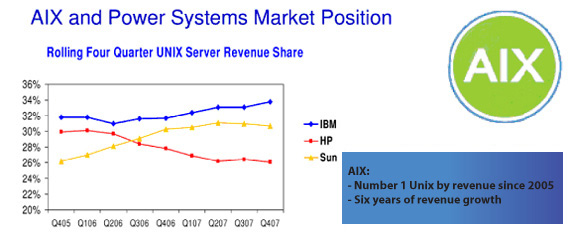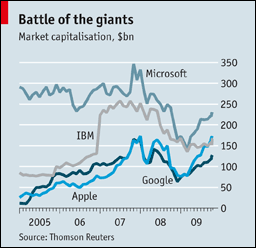December 03, 2009
Unix turns 40 -- the patience of Sun Tzu

The systems world will shortly be celebrating a major anniversary milestone. UNIX® is turning 40 years old! Most of us know the story of how UNIX was born, but what about why? Was it born strictly because its founders wanted to play a computer game on a different platform? And why does UNIX continue to thrive 15 years after an (in)famous Byte Magazine article that asked, "Is UNIX dead?"
Good questions for systems architects. You might not want to study Unix, but you should in your time study the full evolution of a few systems, and compare and contrast: why did this one succeed and others fail? Surprisingly, the reasons are generally different each time. It's almost as if the gods of the market learn and spite us if we copy the past successes, each time.
The very early story:
Ken Thompson developed a game on the GE-645 mainframe called Space Travel. Unfortunately, the game was just running too slow on the GE box, so Thompson rewrote (in assembly) the game for DEC's PDP-7, with the help of Dennis Ritchie. The porting experience led Ken to develop a new OS for the PDP-7. This included a file system as well as the new multi-tasking operating system itself. They included a command-line interpreter and some small utility programs.The project was originally named Unics, and it could eventually support two simultaneous users, which led to some financial support from Bell. In 1970, UNIX became the official name for the operating system, which ran on the PDP-11/20. It also included roff (a text formatting program) and a text editor.
The things to drag out of that is: Very Small Team. No Corporate Direction. And, they did what they needed. What did they need? Roff. Which was used for preparing papers ... which just happens to have been what all academic institutions need from their computers (above all other needs).
Ultimately, it was rewritten in C in 1973, which made it portable and changed the history of operating systems.
OK, sort of. More clearly, it made it readable. So when Computer Science departments started installing it, they found themselves with a readable, understandable and advanced operating system. What does that mean? Teaching! Unix became a favourite in the Universities because it gave a full pedagogical experience. Which lead to a generation of engineers in the early 1980s demanding it.
The portability came later, because these engineers want it. In practice, the first port off PDP-11s was done in Wollongong, as an academic exercise. But in the mid 1980s, the cost of hardware had come down, and the cost of software was rapidly rising. At the crossing point was a demand for a cheap operating system, and this meant "one you didn't have to write yourself" (curiously echoed by Bill Gates' purchase of QDOS for $50k.)
Unix took over the market for all challengers to IBM, because they couldn't beat IBM on its ability to invest in software. See _The Soul of a new Computer_ for a counterpoint, a book every architect should read. Or to be fair, Unix took over "sophisticated" end of the market, and MS-DOS took over the "basic PS" end. Between them, they destroyed IBM -- to then the greatest tech company ever -- in a single decade.
 IBM of course fought back in the 1990s, and adopted Unix as well. However, marketing games roll on. In this article, IBM adopts the "licensed" view of what Unix is, which is either polite to the licensors or deceptive depending on who butters your bread. It misses out the other two gorillas in the room: BSD on Mac and Linux. Does anyone have any figures on operating systems revenues for Mac OSX 10 and Linux family?
IBM of course fought back in the 1990s, and adopted Unix as well. However, marketing games roll on. In this article, IBM adopts the "licensed" view of what Unix is, which is either polite to the licensors or deceptive depending on who butters your bread. It misses out the other two gorillas in the room: BSD on Mac and Linux. Does anyone have any figures on operating systems revenues for Mac OSX 10 and Linux family?
Compare the chart in the IBM article to the one posted a month back.
Why does Unix live on? In part because it can do the serious things, in part because it is simply available, and in part its history was so much more oriented to the net, and it has gradually evolved to be good for it. Whereas the main competitor comes from the user-interface world, and eschewed the net in its core principles until 2002. During the 2000s, Microsoft lost a lot of ground because of security and lack of openness, ground that others were well prepared to take up. To read Sun Tzu:
The good fighters of old first put themselves beyond the possibility of defeat, and then waited for an opportunity of defeating the enemy. To secure ourselves against defeat lies in our own hands, but the opportunity of defeating the enemy is provided by the enemy himself. Thus the good fighter is able to secure himself against defeat, but cannot make certain of defeating the enemy.
Patience also is necessary. Why think about these things? Because the same battles are being fought out today. As in the charts here, but also between facebook and myspace, between blue-ray and HD-DVD, between the gold currencies, between the rebel currencies and the banks, between old media and the new. In each of these battles, the same factors emerge, as do winners and losers, and the only easy way to predict that future is to really study the examples of the past.
(Yes, there are harder and more expensive ways to learn, such as playing it yourself.)
Posted by iang at December 3, 2009 08:16 AM | TrackBacktraditional folklore has been that UNIX was done in response to issues with MULTICS (ge645)
some of the people from CTSS went to 5th flr, 545 tech sq to Multics ... and others went to the science center on the 4th flr.
The science center did virtual machine system ... originally cp40 on 360/40 with custom hardware modifications to support virtual memory. cp40 morphed into cp67 when the science center got a 360/67 that came standard with virtual memory support. combined cp67 & cms group was less than dozen people. I got involved in jan68, when three people came out and installed cp67 at univ. where I was undergraduate.
some multics stuff
http://www.multicians.org/multics.html
there virtual machine history document here
http://www.princeton.edu/~melinda/
that starts with CTSS and traces science center wanting to get the project mac contract (for what became multics). when they didn't, they started cp40.
cp67 (and its successor vm370) not only didn't it have corporate backing ... but corporate hdqtrs periodically had efforts to actively kill it off.
Now there are stories about thousands of "linuxes" being run under mainframe virtual machine system (some demonstrations with tens of thousands in same system).
Remember the signs of the times.
For Unix the clock is running and it is in seconds in a 32bit signed int. The clocks epoch is 1970.
A little calculation will show we've less than ten years to go before "roll over".
Not that it realy maters but it will be an excuse to lift a glass to the passing of an epoch.
Oh one other thing about MS and Unix.
AT&T did a silly thing, they went into the lions den to ask for help.
AT&T wanted some one to port Unix onto the i286 platform. They went with Billy "Boy wunder" Gates.
He in turn found three nerds in a garage with a pumped up name of "The Santa Cruz Operation".
They did the work and in return for a small amount of cash Billy boy took the rights to their work and called it Xenix.
He also made AT&T sign a devils pact. In that every licence for Unix AT&T issued on the x86 platform MS got royalties.
So for those that remember the "server wars" MS could not lose they got the money either way.
As for the three SCO guys hmm not sure what happened to them.
Posted by: Clive Robinson at December 6, 2009 11:13 AM